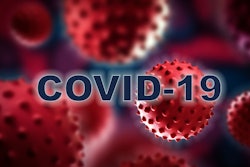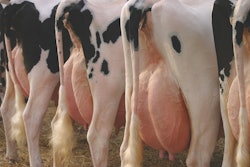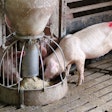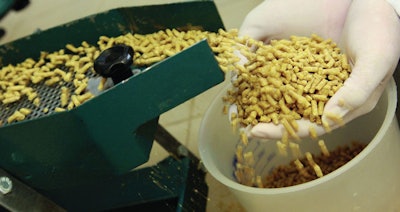
New methods can calculate the performance and cost-benefit of nutritional solutions.
In order to understand the benefits of additives, their mode of action needs to be understood in detail. In the case of enzymes, it is important to study the substrates they act upon and analyze dietary levels. Nutritional specification, formulation details, animal species, genetics, age, health status and production conditions will all contribute to the effect of additives.
Many types of additives are added to poultry diets to improve performance and health, such as enzymes. But how can producers predict whether they will work for them and what the cost-benefit will be?
Enzymes address two important challenges in animal nutrition: reducing feed costs and improving production efficiency. With the aim of meeting a growing demand for animal protein for a burgeoning world population while reducing the environmental impact of animal production, enzymes can allow producers to reduce losses and better utilize nutrients.
Greater understanding of enzymes
Alongside nutritional trials looking at standard parameters of growth, feed efficiency and mortality, some additive manufacturers are delving deeper into their products’ mode of action. This is particularly true of enzymes as scientists develop their knowledge of feed composition. According to Marcio Ceccantini, Adisseo‘s global director for technical and scientific support in food digestibility solutions, the indigestible fraction of monogastric diets can be examined with a new group of parameters for analyzing monogastric feed.
“There are several factors that affect feed digestibility and its susceptibility to enzymes,” Ceccantini said. “These include the presence of anti-nutritional factors in conjunction with intestinal health.”
Phytate reduces the solubility of protein, in turn, negatively affecting digestion and increasing endogenous loss. Arabinoxylans increase the viscosity of the gut and physically prevent endogenous enzymes access to nutrients inside the cell wall, a process known as the cage effect.
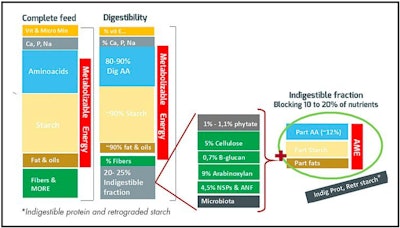 A new group of parameters to analyze mono gastric feed (Adisseo)
A new group of parameters to analyze mono gastric feed (Adisseo)There is a complex relationship in the gut between commensal microorganisms and pathogens or opportunistic microorganisms within the intestinal tract.
“Any imbalance indirectly changes gut morphology, principally crypt depth and villi height,” Ceccantini said. “This impairs performance by reducing nutrient absorption, increasing mucous secretion, causing diarrhea and impairing resistance to disease.”
The greater understanding of these factors and their interaction means that scientists can more accurately investigate the effect of enzymes in a particular situation.
Polysaccharide research
There has been much research showing how enzymes can be used to improve technical and economic performance. The use of this data can help scientists develop new enzyme solutions and predict their effects. The composition and impact of non-starch polysaccharide (NSP) content in cereal grains is being studied.
Dr. Estelle Bonnin, from the French National Institute for Agriculture, Food and Environment (INRAE), has delved further into the topic by describing the diversity of cell wall polysaccharides found in major feed ingredients, in particular, NSPs.
“We need to respond to the diversity of polysaccharides by using multiple and highly specific enzyme preparations,” Bonnin said. “Enzymes have narrow specificity, so the more types included the greater the degradation of NSPs.”
 Indication of the order of magnitude of hemicelluloses in cereal endosperms
Indication of the order of magnitude of hemicelluloses in cereal endospermsThere is a clear relationship where the concentration of NSPs increases, the apparent metabolizable energy (AME) decreases. There is a high level of variability of hemicelluloses in cereal endosperm, e.g. heteroxylans, including arabinoxylans and beta-glucans, and within these groups, there are numerous variations. The type of NSPs present affects diet digestibility and subsequent animal performance.
“Diversity of polysaccharide structures requires diversity of enzymes. This is also true for protein raw materials, which require the breakdown of cellulose, hemicelluloses and pectin,” she said.
How oilseed meals have been processed affects NSP composition, particularly with regard to pectin.
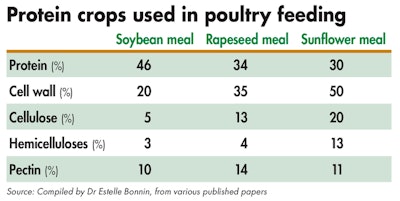 Indication of the composition of protein crops used in poultry feeding
Indication of the composition of protein crops used in poultry feedingPredictive tools
An evaluation of the indigestible fraction of diets should be carried out to predict the effect of a particular enzyme combination. This includes analyzing the nutrient content of this fraction and the anti-nutritional factors (ANFs) it contains. It is then important to know the effect of individual enzymes on ANFs in each raw material used, as well as in complete feed. Enzymes have effects beyond digestibility, including gut function, properties that can have a positive influence on performance, and should be factored into predictive tools. Equations can then be established to calculate the effect of enzymes of both the nutritional value of the diet and animal performance.
A review of the NSP content of raw materials was carried out by Adisseo, analyzing 80 samples by near-infrared (NIR), then comparing values with published data and industry nutrient tables. The results show that there are various levels of anti-nutritional factors in different raw materials. Using this data in combination with predictions of the effects of enzymes can provide AME and AMEn results as if the measure had been made in vivo — bringing nutritionists a step closer to precise nutrition formulation.
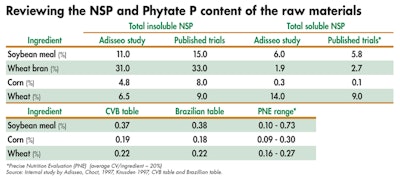 There are variable levels of anti-nutritional factors in different raw materials.
There are variable levels of anti-nutritional factors in different raw materials.Pierre Cozannet, Adisseo research manager, went into more detail on enzyme-substrate relationships, focusing on arabinoxylans.
“Arabinoxylans are antinutritional for both poultry and swine,” Cozannet explained. “The use of carbohydrate enzymes can degrade this NSP, improving the nutritional value of the diet and animal performance. Optimized equations are now available to calculate the benefits of multi-carbohydrases based on the arabinoxylan content of the diet.”
A meta-analysis of enzyme trials in broilers was carried out and data fed into predictive equations, along with raw material analysis. Looking at the results with the control diets highlighted the importance of AMEn, Dig Lys and AvP for animal performance prediction. The calculated enzyme effects can then be predicted based on dietary information.
Genetics play a role
Phytic acid (InsP6) is one of the most important anti-nutrients in monogastric nutrition. It is present in plant seeds where it forms 60% to 80% of phosphorus present. The biological potential of broilers for InsP6 degradation is high (higher than in pigs) due to endogenous enzymes of poultry.
Professor Markus Rodehutscord from the University of Hohenheim explained: “Phosphorus and calcium supplements strongly reduce InsP6 degradation, but phytase can compensate in a dose-dependent manner. Phytase can affect amino acid digestibility and myo-inositol release, a degradation product of phytic acid.”
Myo-inositol concentrations and InsP isomers can assist in the understanding of enzymes’ mode of action. As well as exogenous enzymes, the effect of plant intrinsic phytase and the contribution of the microbiota has been studied.
“The key challenge is to find the right balance between calcium and phosphorus supplements and phytase,” Rodehutscord said. “As well as further understanding how myo-inositol release by phytase affects the plasma metabolome.”
The trial published last year concluded that myo-inositol release can affect specific metabolic pathways and that the effects of phytase may be related to intermediary degradation products.
The way forward
Classes of enzymes have distinct but complementary effects, but one type, whatever the dose, cannot substitute the efficiency of a combination. Any enzyme used should be matched to the substrates found in the feed. If a sufficient substrate isn’t available, then the beneficial effects will not be seen. NIR analysis of raw materials is being used to estimate the presence of both nutrients and anti-nutrients. This information can then be used to help predict the effects of enzymes and refine their usage.
By improving overall feed digestibility by targeting the indigestible fraction of raw materials, releasing nutrients and enhancing gut function, feed has a greater value.
To develop sustainable animal protein production, the industry should be focusing on better nutritional evaluation and less waste of nutrients. Transforming the indigestible fraction within diets with a multi-enzyme solution is one way to do this. Tapping into the dynamic interaction between feed substrates and the animal’s own microbiota improved digestibility and health will help obtain optimal performance and efficient production.
Editor’s note: Information for this article was taken from talks at Adisseo’s Poultry and Swine conferences, held in Paris in October 2019.


